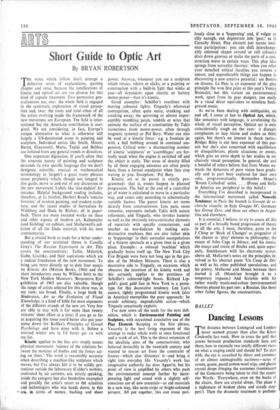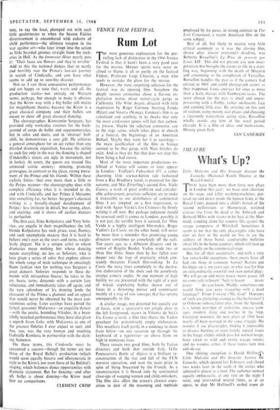Dancing Lessons
BALLET
tory, to say the least, plumped out with such little quaintnesses as when the Season Fairies divertissement is encumbered with cohorts of child performers—the ultimate weapon in the war against art—who later irrupt into the action as little bearded gnomes straight from the rock- eries in Hell. As the Immortal Hour nearly puts it: 'Their faces are flowers and they're terrible.' Add to this the national dances that so neatly and horribly mar the Prince's last-act journey in search of Cinderella, and you have what seems to add up to sure-fire disaster.
Not so. I saw three consecutive performances and am happy to state that, warts and all, the production works—not entirely on Western terms, perhaps, but enough to make it obvious that the Kirov way with a big ballet still makes for magnificent theatre, because the Kirov is a great classical company and their ballets are meant to show off great classical dancing.
The choreographer, Konstantin Sergeyev, has provided only workaday routines for the back- ground of corps de ballet and supernumeraries, but in solos and duets, and in 'abstract' ball- abili, he demonstrates a sure gift. He achieves a general atmosphere for an act rather than any detailed dramatic exposition, because the acting as such lies only in the way the dancing is shaped (Cinderella's sisters are ugly in movement, not in looks). At court, the guests are treated like animated satiric scenery: mincing, prancing grotesques, in contrast to the clean, strong move- ment of the -Prince and his friends. Within these stylistic limits—that owe more than a little to the Petipa manner—the choreography does with complete efficiency what it is intended to do, and with Cinderella and her Prince it blossoms into something far, far better. Sergeyev's classical writing is a broadly-shaped development of Petipa: less intricate in detail, but strong, clear, and exciting: and it shows off perfect dancers to perfection.
The first cast, Irina Kolpakova and Yury Solo- viev, are angelic in their magnificence; the tall, blonde Kolpakova has such grace, ease, fluency, and such unemphatic majesty that it is hard to believe one's eyes as she soars and turns, weight- lessly elegant. She is a unique artist to whom dramatics mean nothing but whose dancing means everything; no less so Soloviev, who is here given a series of solos that explore almost the whole range of male technique in amazingly fluent fashion (not for nothing was Sergeyev a great dancer). Soloviev responds to these de- mands with miraculous finesse; he takes to the air, beats, turns, descends with a certain lazy reluctance, and immediately takes off again; and the very splendour of his dancing lends the character of the Prince a glamour and an appeal that would never be obtained by the most con- scientious acting. Later castings have paired the lyrical, gossamer Makarova—an exquisite dancer —with the poetic, bounding Vikulov, in a beau- tifully matched performance (they have also given a superb Swan Lake, with Makarova as one of the greatest Odettes I ever expect to see); and fine, too, was the very human and touching Gabrielle Komleva in partnership with the dash- ing Semenov.
On these terms, this Cinderella must be accounted a success—though the terms are not those of the Royal Ballet's production (which would seem equally bizarre and idiosyncratic in style to the Kirov), nor even those of the Bolshoi's staging, which balances dance opportunities with dramatic statement. But for dancing—and after all, ballet is about dancingthe Kirov need fear no comparisons.
CLEMENT CRISP



































 Previous page
Previous page